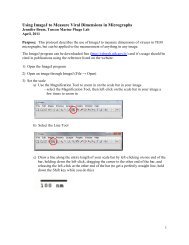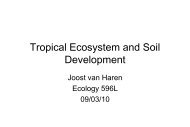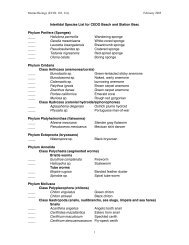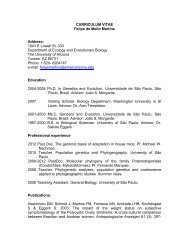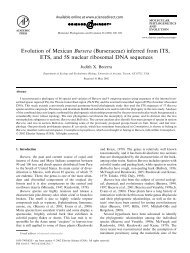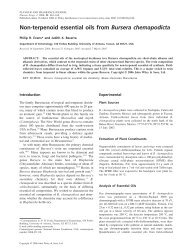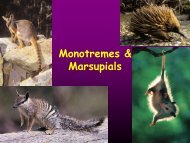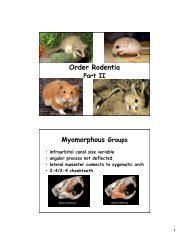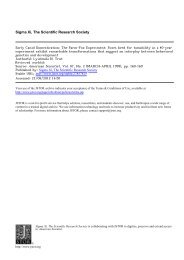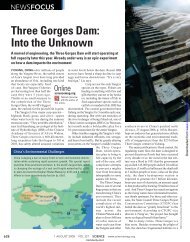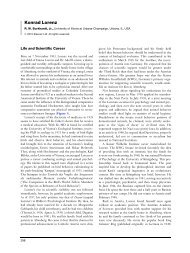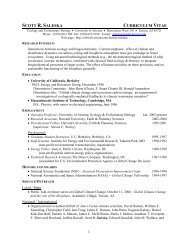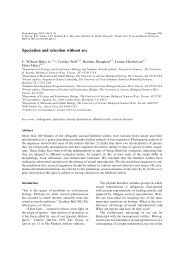6 slides
6 slides
6 slides
Create successful ePaper yourself
Turn your PDF publications into a flip-book with our unique Google optimized e-Paper software.
Lecture 41<br />
28 April 2008<br />
Vertebrate Physiology<br />
ECOL 437 (MCB/VetSci 437)<br />
Univ. of Arizona, spring 2008<br />
Kevin Bonine & Kevin Oh<br />
1. Digestion (Ch4)<br />
http://eebweb.arizona.edu/eeb_course_websites.htm<br />
Generalized Digestive<br />
System<br />
Salivary glands<br />
(mucin) to<br />
lubricate<br />
Tongue for<br />
chemoreception<br />
Foregut<br />
Monogastric Stomach<br />
- strong muscular sac/tube<br />
- sphincters at both ends<br />
1 - mucus from goblet<br />
cells of gastric pit<br />
2 - HCl from parietal cells<br />
of gastric gland<br />
3 - pepsinogen from chief<br />
cells of gastric gland<br />
1<br />
2<br />
3<br />
4<br />
(Eckert 15-17)<br />
3<br />
4<br />
1<br />
1<br />
2 (incl. stomach)<br />
(Eckert<br />
4<br />
15-13)<br />
1<br />
2<br />
Housekeeping, 28 April 2008<br />
Upcoming Readings<br />
Wed 30 Apr: Ch 8, Thermal Physiology<br />
LAB 30 Apr, 07 May: Funding Panel<br />
Fri 02 May: Ch 8<br />
Mon 05 May: Ch 8<br />
Wed 07 May: Review for FINAL EXAM<br />
Foregut<br />
-Conducting, Storage, Digestion<br />
-Esophagus and Stomach<br />
Crop in some for storage/regurgitation<br />
e.g., Some birds use to grind with pebbles and sand<br />
Stomach<br />
- food storage<br />
- begins digestion (e.g., pepsin)<br />
- mechanical mixing (muscular walls)<br />
- Monogastric (1 chamber, carnivores and omnivores)<br />
- Digastric (> 1 chamber)<br />
Foregut<br />
Digastric Stomach<br />
-herbivores<br />
-regurgitation<br />
Domestic cattle,<br />
1L/min gas!<br />
(methane and CO 2 )<br />
-digestive<br />
enzymes<br />
-anaerobic fermentation<br />
by symbiotic bacteria<br />
and protozoans<br />
( Carbohydrates -> sugars and gases )<br />
sugars, amino acids, short FAs into blood<br />
3 6<br />
7<br />
4<br />
3<br />
2<br />
2<br />
5<br />
(Eckert<br />
15-18)<br />
1<br />
1
Midgut<br />
-Chemical digestion and Absorption (~ small intestine)<br />
-from stomach through pyloric sphincter into duodenum<br />
-alkaline<br />
1-Duodenum (mucus + secretions from liver, pancreas)<br />
Bile duct from liver<br />
-Bile breaks up fats and neutralizes acids<br />
Pancreatic Juice<br />
-proteases, lipases, carbohydrases, antacid<br />
2-Jejunum (digestion and absorption)<br />
3-Ileum (mostly absorption)<br />
-Internal symbionts help digest, provide nutrition, vitamins<br />
-Gas exchange in some air-breathing fishes<br />
Midgut<br />
-Intestinal Epithelium, SURFACE AREA<br />
-aids absorption of digested nutrients<br />
-epithelium arrangement:<br />
-circular folds<br />
-villi with blood vessels<br />
-central lacteal (lymph system)<br />
-microvilli (2x105 per mm2 )<br />
Villi with<br />
microvilli<br />
(brush border)<br />
(Eckert 15-20)<br />
8<br />
(Eckert 15-31)<br />
(Eckert<br />
15-19)<br />
(Eckert 15-20) 10<br />
12<br />
Midgut<br />
Anatomy:<br />
-longitudinal smooth muscle<br />
-circular smooth muscle<br />
-epithelium<br />
-submucosa<br />
(connective tissue)<br />
-mucosa<br />
(mucous membrane)<br />
Epithelial cells<br />
sloughed rapidly<br />
(2x10 10 cells/day),<br />
lining replaced<br />
every few days<br />
Midgut<br />
-Intestinal Epithelium, SURFACE AREA<br />
-surface of microvilli:<br />
-covered with glycocalyx<br />
-mucus and water mixed in<br />
-absorption through epithelial<br />
cells<br />
-intestinal chyme<br />
-microvilli with actin, interacts<br />
with myosin for movement<br />
Hindgut<br />
-Water and Ion absorption; Defecation<br />
(Eckert 15-19)<br />
(Eckert 15-20)<br />
-reabsorb water and ions at end of small intestine<br />
(ilieum) and from large intestine/colon<br />
-feces into cloaca/rectum for excretion<br />
-cloaca can also be site of urine modification (e.g., birds)<br />
-bacterial digestion in hindgut fermenters<br />
(especially in cecum)<br />
-coprophagy/cecotrophy<br />
(e.g., rabbits)<br />
9<br />
11<br />
13<br />
2
Hindgut<br />
-Water and Ion absorption; defecation<br />
hindgut fermenters<br />
horse rabbit<br />
Movement<br />
Regurgitation, Vomiting?<br />
(Eckert 15-37,<br />
See Hill 4-19)<br />
(Eckert 15-25)<br />
(Eckert<br />
15-22)<br />
14<br />
Kneading<br />
16<br />
18<br />
Motility<br />
Contraction of gut and movement of contents:<br />
1. Propulsion, expulsion<br />
2. Mixing and grinding (enzymes, mechanical digestion)<br />
3. Stirring so brush border/epithelial lining gets nutrients<br />
Peristalsis<br />
-longitudinal muscle<br />
-circular muscle<br />
Move food along...<br />
ABSORPTION:<br />
-Across epithelium of brush border (microvilli)<br />
-Glycocalyx has enzymes for final cleavage<br />
disaccharidases, aminopeptidases, phosphatases<br />
(Eckert<br />
15-24)<br />
-Simple Diffusion<br />
1 fat-soluble substances<br />
2 small water soluble substances through<br />
regulated aquaporins<br />
3 down concentration or electrochemical gradients<br />
-Facilitated Diffusion and 2° Active Transport<br />
1 monosaccharides and amino acids<br />
2 transporter proteins<br />
3 down conc. gradient or<br />
4 coupled to Na + gradient (Na/K-ATPase)<br />
ABSORPTION<br />
-Active Transport<br />
-amino acids with ~specific transporters<br />
coupled to Na+<br />
-Lipids<br />
-products cross into epithelial cells<br />
(monoglycerides, fatty acids, glycerol)<br />
-reconstructed into triglycerides<br />
-formed into chylomicrons using cholesterol<br />
and phospholipids<br />
-chylomicrons exocytosed<br />
-taken into central lacteal and into lymph<br />
system<br />
15<br />
17<br />
19<br />
3
Lipids<br />
ER<br />
Golgi<br />
Water and Electrolyte Balance in Gut<br />
Lacteal<br />
-Lots of water and electrolytes secreted into<br />
lumen<br />
-Need to recover<br />
(15-38)<br />
-Most via lower small intestine (ileum)<br />
-Osmotic gradient b/c absorb salts, carbos, amino acids<br />
-Tips of villi<br />
-Countercurrent exchange with high Na+ (Cl - follows) to<br />
facilitate water reabsorption<br />
Los Secretions<br />
Alimentary canal is largest endocrine and exocrine gland<br />
Salivary gland<br />
Secretory cells of stomach and intestine<br />
Secretory cells of liver and pancreas<br />
Water, ions, mucus, enzymes<br />
Bile (fat digestion)<br />
-created in liver, stored in gall bladder<br />
-also gets rid of some waste products<br />
metabolized by liver<br />
-Why is your poop brown?<br />
20<br />
22<br />
24<br />
Nutrient Transport in Blood<br />
-lipids (chylomicrons) into blood from lymph at<br />
thoracic duct<br />
-sugars and amino acids into capillaries of villi<br />
-to liver via hepatic portal vein<br />
sugars converted to glycogen for storage<br />
Secretions etc.<br />
(15-39)<br />
Los Secretions (order and triggers)<br />
Gastric<br />
Pepsin (pepsinogen) from chief cells<br />
-response to:<br />
1 parasymp. stim.<br />
2 gastrin<br />
-breaks peptide bonds<br />
=<br />
(15-35)<br />
ileum<br />
Mucus from goblet cells<br />
-protects gut lining<br />
-works with alkaline electrolytes in glycocalyx<br />
21<br />
23<br />
25<br />
4
Los Secretions (order and triggers)<br />
Gastric<br />
Gastrin from endocrine cells of distal stomach mucosa<br />
-response to:<br />
1 gastric chyme with proteins<br />
2 stomach stretch (gastric distension)<br />
- binds to smooth muscle<br />
- stimulates stomach motility<br />
- stimulates HCl and pepsin release<br />
Intestine<br />
Gastric Inhibitory Peptide (GIP) from duodenum<br />
-response to:<br />
1 entry of fats and sugars<br />
- acts to stop gastric secretion and motility<br />
~opposite<br />
effects<br />
(also Enterogastric Reflex and sympathetic stimulation) 26<br />
Control of Los Secretions<br />
Presence of Food stimulates:<br />
Chemoreceptors lead to activation:<br />
1 Autonomic Efferent Neurons<br />
2 GI hormones into blood stream<br />
-stimulates liver, pancreas, gut<br />
Mental influences<br />
-conscious decisions<br />
-learned smells, sounds<br />
-Pavlovian response<br />
Gastrointestinal secretions controlled by hormones:<br />
-endocrine cells of gastric and intestinal submucosa<br />
-complicated, varies in areas of gut<br />
28<br />
Vitamins and Minerals<br />
Vit A<br />
(retinol, retinal; rhodopsin)<br />
Water Soluble:<br />
B Vitamins, Vitamin C<br />
Lipid Soluble:<br />
Vits A, D, E, K<br />
Metalloproteins (e.g., hemoglobin)<br />
30 31<br />
27<br />
29<br />
5



